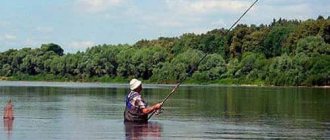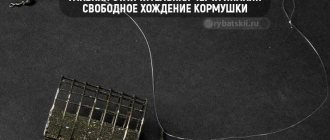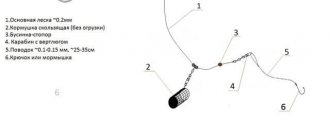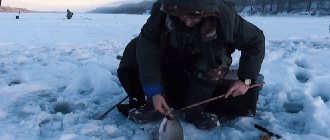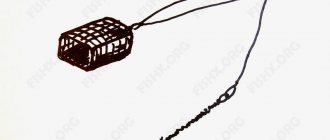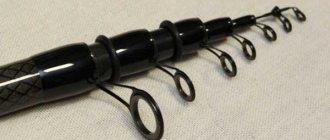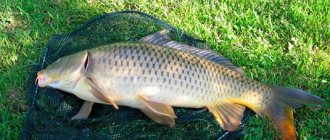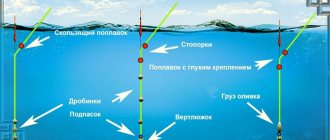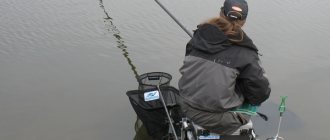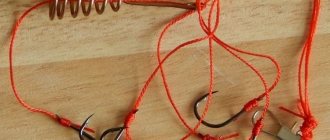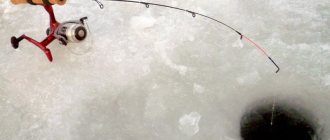Feeder equipment is an integral part of any fishing for peaceful fish. The outcome of your fishing will depend on the correct selection, installation and preparation of equipment. The mistake of many fishermen is that they underestimate the importance of feeding the fishing point in one place.
Due to the great popularity of feeder fishing, the variety of gear is quite large, but not all of them work. Today we will talk about the best gear for feeder fishing in currents and in still water, and also pay attention to how to make them yourself.
Popular types of feeder equipment
Among fishermen, 8 types of installation of feeder gear are especially popular. We decided to first introduce you to the list, and then take a closer look at each of them and talk about how to make this gear yourself.
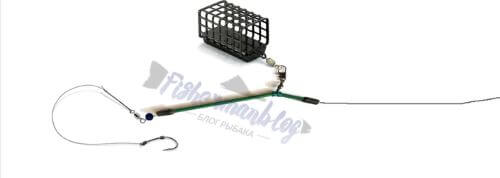
- Self-cutting feeder equipment, symmetrical loop
. This is one of the simplest gear of the loop system, which is particularly sensitive. It has not found its application in fishing in the current, but it catches perfectly in still water. - Self-cutting tackle asymmetrical loop
. This tackle is very often used by fans of feeder fishing in strong currents, since due to the lack of symmetry the leash practically does not twist. It is used much more often than the gear described above and is its improved model. - Inline tackle (In-line)
is known to many fans of fishing for carp and other white fish on a feeder; due to its simplicity and efficiency, it is very popular among fishermen. Among the features of the equipment is a sliding sinker, mounted in such a way that it can be easily replaced with a small Method type feeder. Most often used for fishing in reservoirs with standing water. - The Method
feeder fishing tackle involves the use of a feeder, which is how it got its name; the Method feeder has a lot in common with the classic nipple. When using more viscous bait, you can easily hide hooks in the feeder and fish like a regular nipple. - Gardner loop for feeder (Paternoster)
. For lovers of fishing in reservoirs with muddy bottoms, this equipment simply has no equal among other well-known equipment. Even when the feeder is not completely immersed in the silt, the tackle continues to notify the fisherman well of bites and transmits every jerk of the fish. Due to the fact that the feeder is attached to the main line using a twist, the leash will not overlap during casting. - Self-cutting tackle helicopter
. Often used by anglers for long-distance fishing. It is very often used when fishing for crucian carp using a feeder in reservoirs with a large amount of silt at the bottom. - Feeder tackle combine
. Surely the tackle came from lovers of tubes with an anti-twist; for fans of such tackle, mounting the feeder on a tube was not enough and they decided to attach it to a loop about 10-15 centimeters long, which in turn is attached to the tube. This type of installation allows the use of gear in reservoirs with difficult daytime topography. - Feeder equipment with anti-twist tube
. To make such gear, a special tube is used, to which the feeder is attached. A special feature of this tube is that it bends 2/5 of its length. It is indeed possible to avoid tangling of the fishing line with such tackle, but the tackle loses its relevance due to its bulkiness and the need to use additional accessories.
Fishing with a feeder from a boat
To fish on a feeder from a boat, you need to select a point and successfully anchor. Only after this can you proceed to the starting feeding of the area.
Note!
The bait mixture is prepared in advance on the shore so as not to create additional noise on the boat that scares away the fish.
The tackle is equipped with a volumetric feeder. The measured length of the fishing line is fixed with a clip, which helps the bait ball to accurately hit one point.
For starter feeding, it is enough to add a third of the finished mixture. The rest of the feed is thrown in every 10-15 minutes during the process of catching fish on the feeder. After installing a small feeder on the feeder, you need to begin installing the leash with a hook. Having planted the bait, the fisherman proceeds to filling the feeder with the bait mixture. Having completed an accurate cast, the tackle is installed on board.
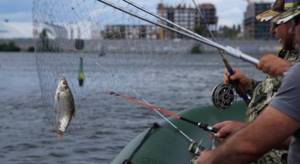
The process of fishing from a floating craft is difficult, because the fisherman cannot find a reliable foothold on the boat. Large carp or carp often take advantage of the resulting slack in the fishing line and get off the hook. When fishing for a large trophy, it is better to let it get tired at a great distance from the boat and only after weakening its resistance, speed up the process of bringing it into the landing net.
Fishing with a feeder is an exciting process that not only brings pleasure to the fisherman, but also provides him with a decent catch. If there are no bites for an hour, you should move to another place or use other baits. Using various devices and going fishing in different bodies of water, you can quickly learn the tricks of feeder fishing.
Symmetrical and asymmetrical loop
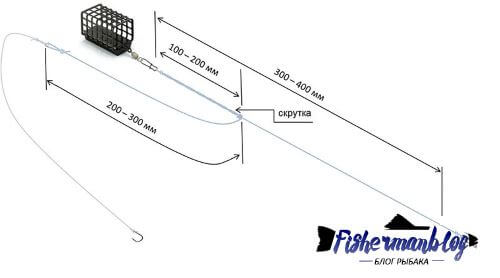
Installation of feeder equipment, an asymmetrical or symmetrical loop, is based on the free sliding of the feeder along the loop system. If you plan to change the feeder while fishing, you need to secure it with a carabiner or swivel.
Tangling of the equipment can be avoided by tying the leash to the main line using loop-to-loop mounting, and lengthening the twist to which the feeder is attached by several centimeters. This way the tackle will be as rigid as possible, and the leash will not get tangled.
In order to avoid any troubles while fishing, it is worth making feeder rigs with a minimum amount of excess fishing line. It is best to hide the tails of the fishing line in cambrics.
Installation
- It is necessary to fold a piece of fishing line about 20-30 centimeters long in half.
- Now make a twist from this piece of fishing line.
- The end of the twist must be secured with a double knot.
- Now you need to pass the swivel with the clasp through the long side of the twist. This action is necessary to quickly replace the feeder.
- Now measure the length of the desired loop and remove the excess fishing line.
Characteristics
- Fishing efficiency on current: 100%;
- Fishing efficiency in still water: 80%;
- Probability of entanglement: 20%;
- Installation difficulty level: 10%;
- Designed for catching bottom fish.
Hooks
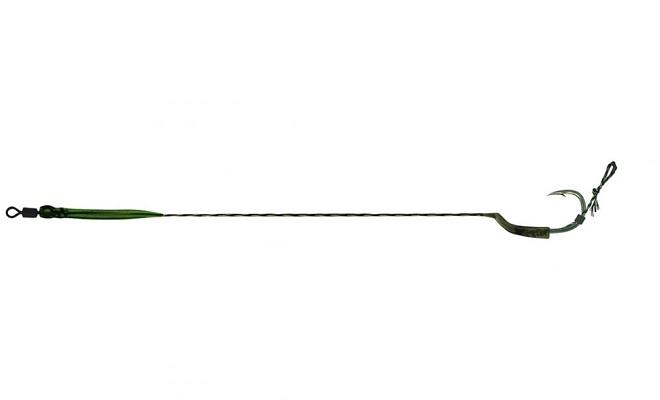
Feeder fishing is carried out with different types of hooks, which depend on the type of bait used. Depending on the volume of the bait, hooks with sizes from 10 to 16 units are used. The requirements for hooks do not differ from generally accepted fishing standards, and these are the sharpness of the tip and an elastic steel composition that does not lose its shape under loads. The color of the accessory is selected to match the shades of the attachments.
Important! For animal baits, bloodworms, maggots and worms, thin hooks are suitable, which injure the bait to a lesser extent, prolonging the active phase of its behavior in the water.
The thickness for plant attachments does not matter much. The main thing is that the bait stays securely on the hook. The selection of the shape of the hook fastening element depends on the fisherman’s ability to correctly and securely tie the accessory to the leash.
Helicopter
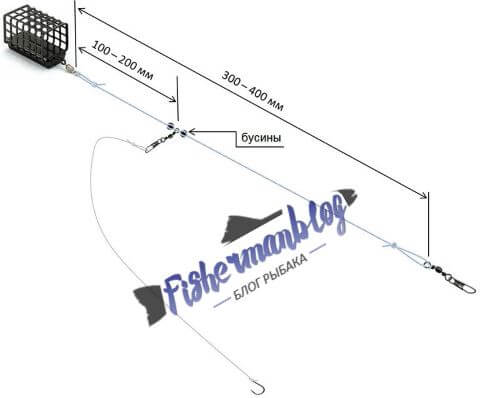
This feeder fishing rig is most suitable for catching white fish on rivers with moderate to high currents
. The tackle is self-cutting, which is why it has gained particular popularity among feeder fishing enthusiasts.
If we talk about the best feeder equipment for fishing in the current, then the helicopter will be one of the best. It is best to install the feeder rod so that its tip forms an angle of 45 degrees with the fishing line. This will avoid tangling, since the hook will be at a sufficient distance from the feeder.
Installation
- First you need to thread the line through the silicone stopper.
- Then you need to put a swivel on the tackle.
- Now secure the swivel using the second stopper, on the opposite side of the rig. There is no need to press the stopper too hard - the swivel should rotate freely.
- You need to tie a feeder feeder to the end of the fishing line, so that you can freely adjust the distance between the swivel and the feeder.
- The tackle is ready.
If it is necessary to make a blind installation, then it is necessary to drip glue under the stoppers.
Characteristics
- Fishing efficiency on current: 60%;
- Fishing efficiency in still water: 10%;
- Probability of entanglement: 70%;
- Installation difficulty level: 50%;
- Designed for catching bottom fish in autumn, not suitable for summer fishing.
Leashes
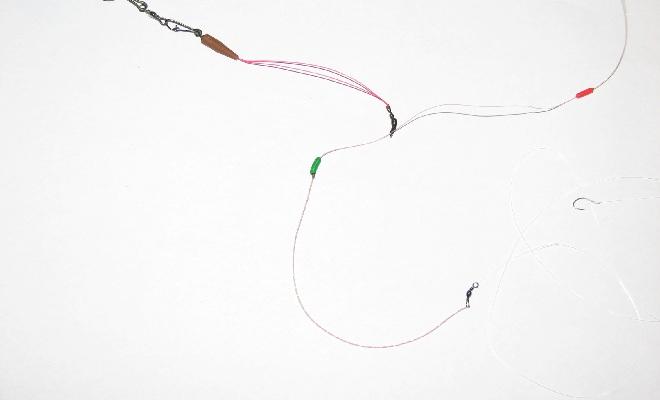
It is recommended to use an element such as a leash made of nylon fishing lines, which are softer in structure, which does not alarm the fish so much when biting. Nylon makes the rigs more delicate, and therefore allows you to increase the number of bites. The length of the leader material depends on the activity of the fish and generally fits into sizes from 20 to 70 cm.
Important! The more active the fish, the shorter the leash length is needed.
Sometimes, with passive fish, fishing on a feeder on the river is carried out with extended leashes, reaching lengths of 1-1.5 meters. For leashes, line diameters range from 0.10 to 0.20 mm. The best results are shown by transparent and black monofilament. For feeder fishing, leashes of various lengths are prepared in advance at home, which makes it possible to adapt to the existing fishing conditions while fishing without wasting time.
Harvester
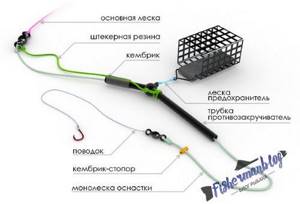
The helicopter feeder equipment involves the use of an anti-twist tube as the main element. But this in no way connects it with the equipment, which will be discussed below. The connecting link between the feeder and the tube is a loop of fishing line.
It is thanks to the ability to change the length of the loop to which the feeder is attached that the feeder equipment is suitable for the river. But for reasons unknown to many, in stagnant water its effectiveness decreases sharply and the fish simply refuse to bite.
Installation
- It is necessary to mount the swivel on the tube.
- You need to tie a piece of fishing line about 10-15 centimeters long to the swivel.
- Now tie the feeder to a piece of fishing line.
- After this, you need to stretch the fishing line through the tube and secure it with a cambric.
- Tie a leash.
- The equipment is ready for use.
Characteristics
- Fishing efficiency on current: 65%;
- Fishing efficiency in still water: 15%;
- Probability of entanglement: 60%;
- Installation difficulty level: 70%;
- Designed for catching bottom fish in autumn, not suitable for summer fishing.
Feeder equipment with anti-twist
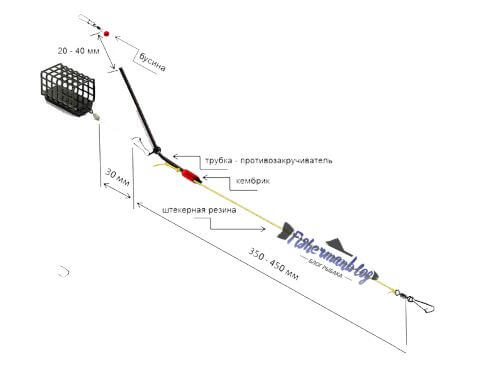
Feeder equipment with an anti-twist is considered one of the most common equipment, most likely due to the ease of its manufacture and use. The part of the tube that is longer must be turned towards the leash to eliminate the possibility of tangling.
This is the best feeder equipment for fishing in still water; it is also suitable for fishing in reservoirs with a current, but it works much worse there. The likelihood of the leash getting tangled with such equipment is minimal, but you will have to hook the fish yourself.
Installation
- First you need to thread the fishing line through the tube, which is equipped with special stoppers.
- Now you need to attach a swivel to the bottom of the rig.
- Tie the leash to the swivel.
- Now all that’s left to do is hook the feeder onto the carabiner.
To minimize tangling of the equipment, it is necessary to direct the long part of the tube towards the leash.
Characteristics
- Fishing efficiency on current: 60%;
- Fishing efficiency in still water: 80%;
- Probability of entanglement: 10%;
- Installation difficulty level: 0%;
- Designed for catching bottom fish, this tackle is especially suitable for catching bream.
In-line (inline)
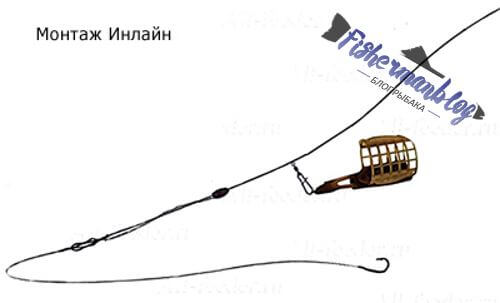
This type of installation lends itself quite well to various changes; one of the most common techniques among fishermen is the possibility of mounting the feeder on a blind or sliding installation. Some fishermen prefer to secure the feeder using silicone stoppers, and some use a stopper knot.
Fans of carp fishing with feeder gear recommend installing a “method” type feeder to such gear to increase its catchability. This type of tackle allows you to fill the feeder with viscous bait and insert hooks into it, like a classic donka.
Installation
- If you are going to make equipment with blind installation, then you need to put a silicone stopper on the fishing line or tie a knot.
- Pass the fishing line through the tube located inside the feeder.
- Put on the second stopper or any other limiter.
- Now you need to make a regular loop, a figure eight knot will help you with this. For those who do not like to tie knots, you can use a swivel. The main purpose of this loop is to attach the leash.
- Remove excess line.
- The tackle is ready.
Characteristics
- Fishing efficiency on current: 100%;
- Fishing efficiency in still water: 80%;
- Probability of entanglement: 10%;
- Installation difficulty level: 40%;
- Designed for catching bottom fish, a special feature of the equipment is the rapid immersion of the leash due to the short distance to the feeder.
Gardner's loop (paternoster)
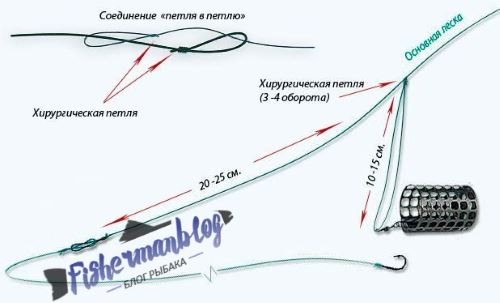
One of the most universal types of installation, this do-it-yourself feeder equipment can be done in a matter of minutes, and even a child can handle its production. The main thing you need to be able to do is knit the simplest knots for fishing, then making equipment will not cause you any special difficulties.
Many fishermen cannot understand why it is so easy to make such equipment. And everything is elementary - due to the fact that installation is carried out on the main fishing line, and only the simplest knots are additional connecting parts, such installation is very simple.
Installation
- Take the main fishing line and tie a loop at its end, to which the leash will then be attached.
- Now make a few turns around the loop and tie another knot.
- Measure approximately 10-15 centimeters from the previous loop and tie another one, only larger. The main task of this loop is to install the feeder.
- Now you should have some rings through which you need to pass the fishing line.
- Now pass the larger loop through the swivel of the feeder, and throw the loop itself over it.
- Now you can tie the fishing line to the swivel.
- Then tie the leash in a loop-to-loop manner.
- Remove excess line.
- The tackle is ready.
Characteristics
- Fishing efficiency on current: 80%;
- Fishing efficiency in still water: 75%;
- Probability of entanglement: 20%;
- Installation difficulty level: 0%;
- Designed for catching bottom fish; most often this tackle attracts bream.
Equipment with feeder rubber
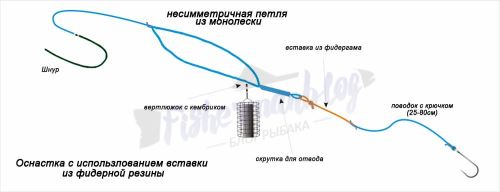
Feeder equipment with Feeder Gum (this is the original name for feeder rubber) has gained popularity among fishermen relatively recently. Feeder rubber is a material of various colors, which is the connecting link between the equipment and the leash.
The photo above shows the simplest gear of this type, it is a classic asymmetrical loop (but the material can be used in any other installation), to which the leash is attached through a small piece of rubber (its length is about 15 centimeters). Some anglers prefer gear that is entirely made of such material (for example, inline or helicopter gear).
The main purpose of using this material is to increase casting distance, minimize tangling and precise hooking. If you buy high-quality rubber that is not afraid of cuts and other external damage, then you can safely use such gear in areas of the reservoir with a problem bottom. Thanks to the excellent shock-absorbing properties of the feeder rubber, breakages of leads and fish coming off the hook are reduced to zero.
Equipment for fishing on the current

To fish in such reservoirs, you need to know and be able to hold the feeder at the feeding point and be able to correctly use feeder equipment for the current. There are different types of feeder equipment, but it is best to use a paternoster, asymmetrical or symmetrical loop, helicopter or combine
.
But the question of which feeder equipment for river fishing will work best in the current has been on the minds of fishermen for many years. And no one ever received an answer to them. Because the success of fishing depends on many factors, and the right equipment is only one of them.
Let's say that you have chosen the tackle, but how to keep the feeder at the feeding point? And for this there are several simple recommendations, following which there will be no problems when fishing in reservoirs with a current:
- Use fishing line with the smallest possible cross-sectional area;
- The shape and weight of the feeder is selected depending on the flow speed;
- To minimize line-water contact, try to position the feeder rod as high as possible.
Keeping the feeder in place when fishing in the current practically does not depend on the chosen gear, but it greatly affects the tangling of the leash. But the balancing of the gear has the greatest influence on overlaps. If you mount the tackle with a heavy feeder, then hooking wary fish will be an overwhelming task. And if you use a light feeder, you will not be able to keep the tackle at the feeding point. Choose a medium-weight feeder to keep it in the current and not scare away the fish.
.
A mistake many novice fishermen make is incorrectly balancing the equipment or neglecting it. At first glance, this seems like a mere trifle, but once you manage to choose the right weight and shape of the feeder for the fishing conditions, you can catch a lot of fish
Feeder on the river and current
On some resources you can read information like “it’s difficult to fish with a feeder in the current” and stuff like that. However, the classic heavy and extra-heavy caliber feeder is just suited for fishing at long distances in current conditions. The feeder came to us from England, where there are practically no such reservoirs, with light feeders and fishing rods. We have the Volga and its tributaries, the Don, and the mighty Siberian rivers.
Very quickly, domestic fishermen adapted the feeder for fishing in just such conditions. And manufacturers have caught up to the demands - on the shelves you can find powerful fishing rods, thin braid and heavy feeders. If earlier on the Don or Volga in some places there was nothing to do without a boat, now feeder gear makes it possible to fish at such points from the shore. And equipping yourself with a feeder is much cheaper than buying a boat.
Fishing with a feeder in the current is not a difficulty, but what the river version of this gear is designed for. The feeder equipment on rivers with strong and weak currents is different. If you can fish with the river version of the equipment on the riser, then on the current it’s the other way around – gear not configured for such conditions will not work. If a feeder for a river with a current of medium strength can be in a medium version, to work with feeders up to 90 grams, then on a fast flow you may need heavy feeders, sometimes 120, 140 grams, and, accordingly, rods with the required dough.
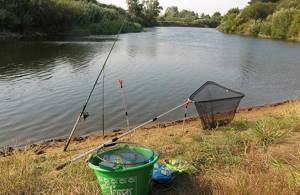
Feeder gear for fishing in still water

The main difficulty in fishing with a feeder in a reservoir with standing water, as opposed to a current, is not keeping the feeder at the feeding point, but the correct selection of bait and its viscosity to attract fish to the bait. When using feeder equipment for still water, you should pay special attention to the choice of fishing location: this is the key factor here.
Try to find any anomaly at the bottom of the reservoir; it is best to look for deep holes; this can be done using a marker rod or echo sounder. The main task of the fisherman when casting is to deliver the equipment to one point throughout the entire fishing trip; to do this, it is best to secure the line using a special clip on the reel.
For fishing in still water, the best gear is a symmetrical loop; the Gardner loop is much less commonly used. It is best to take feeders that are square or pear-shaped, and its weight is selected depending on the depth at the fishing site; often feeders of 30-50 grams are taken.
Features of feeder fishing
- To rig the feeder correctly, you need to understand the importance of the overall balance of the gear. You can tie the feeder installation to the donkey - perhaps this will give results. This does not mean that a fishing rod made this way is a feeder tackle.
- Everything in the feeder is interconnected. Depending on the range and strength of the current, the operating weight of the feeder is selected, and this affects the choice of a rod for such fishing - a heavy class for rivers with strong currents, a picker for close range and working with light weights. Accordingly, gear of different calibers is equipped differently.
- A feeder is a delicate tool, and specific gear is designed and adjusted for narrow fishing conditions. However, in these specific conditions, with correctly selected equipment, the feeder has no equal in terms of catchability. Donka is a general-purpose weapon, and feeder is a high-precision modern missile. In order to properly equip a feeder rod, you need to clearly understand the conditions for which the gear is set.
Basic article about feeder fishing tactics and techniques:
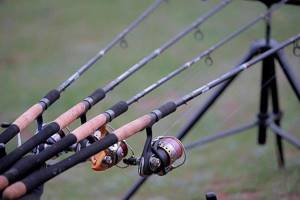
Choosing a rig depending on fishing conditions
The dependence of the bite and type of fish on the choice of feeder equipment has not been proven by anyone. Any feeder equipment listed above can equally well please a fisherman with a trophy carp or a small crucian carp. Different installation methods are primarily aimed at ensuring comfortable fishing in certain conditions.
, but not in any way to take into account the habits of the fish.
Casting distance, wind speed, current, fishing time - these are the main factors that influence the choice of installation. For fishing in still water
, on lakes, reservoirs or rivers without a current, experienced fishermen will prefer the Gardner loop. With this installation, you can easily replace the leash without even using a flashlight for fishing at night. But, if in fishing conditions you need to use a long leash, then such tackle will not be the best choice.
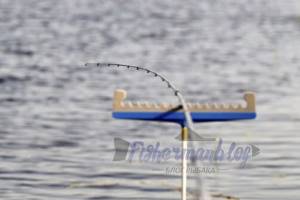
The main task of the equipment when fishing in the current
– deliver the hook with bait into the stream from the eroding bait; this is best done with a Gardner loop and a helicopter feeder rig and two knots. If the fish bites towards the shore, then in such cases the asymmetrical loop tackle will better show the bite.
When fishing at night
It is very convenient to use feeder equipment with an anti-twist tube. Although the casting range of such gear leaves much to be desired, the absence of tangling of the leash makes it advantageous in night fishing conditions.
Feeder equipment is being improved literally every year; amateurs and professionals continue to come up with the best and catchiest equipment. And only years of practice, the characteristics of the reservoir, as well as the personal preferences of the fisherman determine the necessary fishing gear.
Important components of feeder equipment and their properties
Main line. When installing a feeder fishing rod, monofilament fishing line is used. We recommend paying attention to the following brands: Mikado Sensei Feeder, Trabucco T-Force feeder, Shimano Technium.
The diameter of the monofilament is 0.2-0.24.
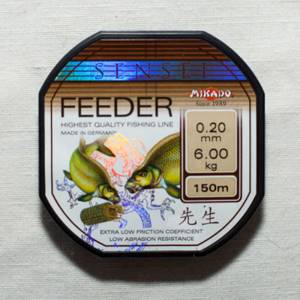
Mikado Sensei Feeder. Price: 180 rub.
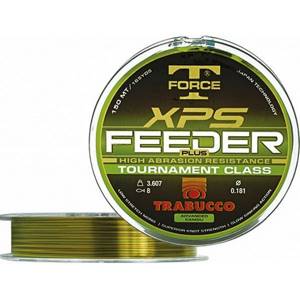
Trabucco T-Force Feeder. Price: 350 rub.
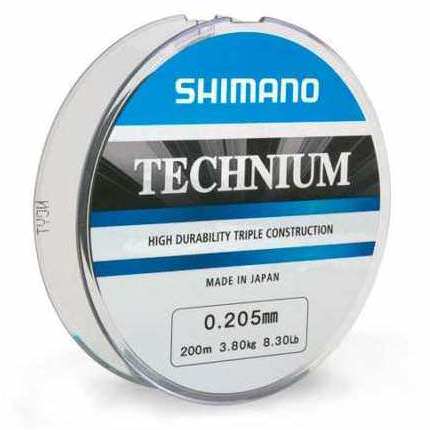
Shimano Technium. Price: 1150 rub.
We do not recommend the brands Salmo, Colmic, Gamakatsu, Owner, Suffix due to their insufficient hardness. In feeder fishing, it is very important that the line does not stretch. This allows the tackle to remain sensitive to bites and accept even the smallest touches of the fish on the tip of the rod.
Attention! Why don't we use braided line?
The fact is that feeder fishing involves constant rubbing of the fishing line on the bottom of the reservoir. Braid is susceptible to rapid abrasion, while monofilament, on the contrary, practically does not deform when in contact with gravel, stones and snags.
However, quality braided line is used in competitive fishing. If you want, we recommend Pontoon 21 Extreama 0.14-0.16 mm. Price: 1050 rub. for 100 m.
Fluorocarbon leashes. The hook is tied to a fluorocarbon line (fluorocarbon) for two reasons:
- This line is almost invisible in the water and does not scare the fish.
- It has increased rigidity, and this reduces the tangling of equipment. The length of the leads, depending on the equipment, is 10-100 cm. For example, in the Method equipment it is 10 cm, and in the Helicopter and two knots it is 100 cm.
Best models: Pontoon 21 Grand Fluorocarbon and Owner Broad Game Pro 0.1-0.31 mm.
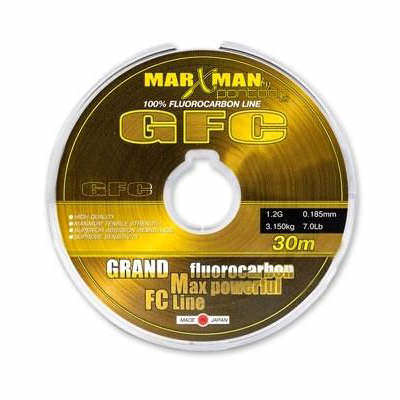
Pontoon 21 Grand Fluorocarbon. Price: 655 rub. Owner Broad. Price: 330 rub.
There are ready-made leashes on sale: Owner RL 340 (thin hooks for bream), RL 330 (yellow hooks for corn), RL 044 (dark hooks for a worm). A choice for those who do not want to knit a leash with a hook and make a loop to the rig themselves.
Thickness of leashes. For a leader with a hook, use 0.1-0.2 mm depending on the weight of the intended fish. Up to 1 kg of production, 0.1 mm of fluorocarbon will be enough for you. The Running Feeder Rig and some others use a 0.3mm rigid fluorocarbon line take-off.
Swivel with carbine. It is important to choose a swivel commensurate with the feeder feeder, especially when using non-branded models. We recommend using an Owner swivel No. 14 when using a feeder larger than 60 g, and when fishing in still water using a small feeder - No. 12.
Important! Use a swivel only in black or dark colors, but never gold. Bright elements of equipment can scare away fish.

Crimping tube for loops
Crimping tube. An optional element, but can be used to make some equipment that uses thick monofilament fishing line. The crimp tube helps secure the hook to the fishing line without using knots at all. Nevertheless, we advise beginners to study the basic nodes and use them first.
Feeder. In total, 7 types of feeder weights are used in feeder gear, differing in their design. Key parameters to pay attention to:
- Feeder shape. Round and spiral are suitable for fishing in still water and in the absence or very weak current. Square and flat feeders are ideal for fishing in the current, as their shape does not allow the current to move the feeder from its place.
- Weight. Feeders up to 30 g are ideal for fishing in still water, and at the same time, you can throw such a load with a feeder rod at 50-80 m quite easily. For fishing in the current, use heavier feeders. Weight depends on the strength of the current and the depth of fishing. For example, in the Volga region on the Volga they use 120 g square feeders.
- Presence of thorns. Again, when fishing in the current, use feeder feeders with spikes.
- Shape and placement of the sinker. Important for the quality of self-tapping of feeder equipment. The more massive the side of the sinker is close to the hook, the harder it will be for the fish to move it, therefore the quality of hooking increases.
- Closed or open types. The closed feeder is designed for small feed that is easily sprayed into the water. The most popular are the spring and feeder for animal baits. Open - with a sharp pull, it is easily freed from the bait, pouring out in the right place. Varieties: cylindrical, rectangular, “curler”, container, “Method” (Method), with spikes and a bullet feeder that flies well.
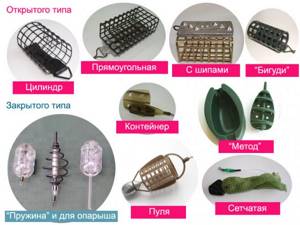
Limit stop. The element is important for protecting the units from the heavy elements of our installations. Use hard rubber stoppers, soft plastic is a little worse, and it’s much worse to use beads as a stopper because of their hardness. Sooner or later they will damage the node.
Anti-twist tube. It is useful in equipment with the same name (the second name is “rocker arm” or “anti-twist tube”). Serves to move the fishing line with the leash to the side, which reduces the number of tangles in the equipment. They are used in currents and extremely rarely in still water due to the massiveness of the element.
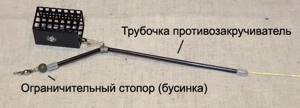
Anti-twist tube and bead stopper
Hooks. Choose sharp, strong hooks that won't bend or break. Editor's Choice – Owner. The standard size for the feeder is No. 6-8. But for catching medium and small fish, they use up to No. 16 (roach, bream, silver bream), and when catching bleak on a floating rig - No. 20.
Hook sizes according to Owner classification
There are other elements, but they are used less often and we will talk about them further.
Installation of feeder gear
Equipping a rod for feeder fishing is quite simple; all you need to do is follow the basic rules and sequence of actions:
- First you need to assemble the feeder rod (if using a telescopic rod, unfold it).
- Now you need to secure the coil.
- Thread the line through all the guides on the rod.
- Now you need to tie a figure eight knot at the end of the main line and attach the feeder equipment to it.
Installation features
Feeder equipment often allows you to hook fish without the participation of the angler. Self-tapping equipment includes paternoster, helicopter, and asymmetrical and symmetrical loops. Hooking of fish occurs due to the weight of the feeder. Let's try to describe this process in more detail:
- Thanks to the long leash, as soon as the fish takes the bait into its mouth, it does not feel the weight of the feeder at all.
- And when it travels a certain distance (depending on the chosen equipment), it is detected at speed, thanks to the weight of the feeder.
Feeder fishing is a very exciting activity that allows you to catch almost all types of peaceful fish. This type of fishing can be called active, since fishing occurs very quickly and dynamically. And if you use not just one feeder equipment, but several, you completely forget about everything. A sea of pleasure and emotions on such fishing is guaranteed.
What is a fishing feeder
Feeder fishing is based on the principles of synchronized supply of bait and targeted feeding of fish in a certain fishing zone, which significantly increases the likelihood of bites. The word feeder itself means to feed, which fully characterizes this bottom method . The equipment included with a cord with a feeder and a hook is the basis. It is based on feeder gear in the form of a fishing rod specially designed for this method with a large number of throughput rings and the ability to change the sensitive tip, called a quivertip. To store the fishing line, deliver the rigs to the fishing point and reel in the caught trophy, a spinning reel with certain performance characteristics and the presence of a clip for fixation, determined for casting the length of the cord, is used.
